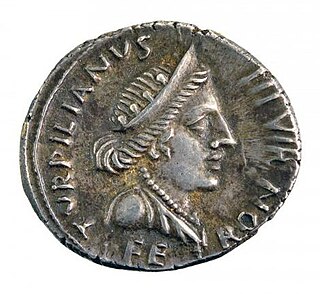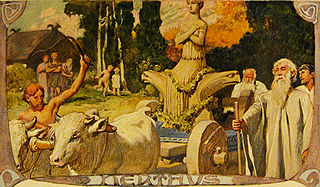 W
WIn ancient Roman religion, Ceres was a goddess of agriculture, grain crops, fertility and motherly relationships. She was originally the central deity in Rome's so-called plebeian or Aventine Triad, then was paired with her daughter Proserpina in what Romans described as "the Greek rites of Ceres". Her seven-day April festival of Cerealia included the popular Ludi Ceriales. She was also honoured in the May lustratio of the fields at the Ambarvalia festival, at harvest-time, and during Roman marriages and funeral rites.
 W
WIn Aztec mythology, Chicomecōātl [t͡ʃikomeˈkoːaːt͡ɬ] "Seven Serpent", was the Aztec goddess of agriculture during the Middle Culture period. She is sometimes called "goddess of nourishment", a goddess of plenty and the female aspect of maize.
 W
WIn ancient Greek religion and mythology, Demeter is the Olympian goddess of the harvest and agriculture, presiding over grains and the fertility of the earth. She was also called Deo (Δηώ).. Her cult titles include Sito (Σιτώ), "she of the Grain", as the giver of food or grain, and Thesmophoros, "giver of customs" and/or "legislator", in association with the secret female-only festival called the Thesmophoria.
 W
WEgeria was a nymph attributed a legendary role in the early history of Rome as a divine consort and counselor of Numa Pompilius, the second king of Rome, to whom she imparted laws and rituals pertaining to ancient Roman religion. Her name is used as an eponym for a female advisor or counselor.
 W
WIn ancient Roman religion, Feronia was a goddess associated with wildlife, fertility, health, and abundance. As the goddess who granted freedom to slaves or civil rights to the most humble part of society, she was especially honored among plebeians and freedmen. Her festival, the Feroniae, was November 13 during the Ludi Plebeii, in conjunction with Fortuna Primigenia; both were goddesses of Praeneste.Note that the similar-sounding Feralia on February 21 is a festival of Jupiter Feretrius, not Feronia.
 W
WKamadhenu, also known as Surabhi, is a divine bovine-goddess described in Hinduism as Gou Mata, the mother of all cows. She is a miraculous "cow of plenty" who provides her owner whatever he desires and is often portrayed as the mother of other cattle. In iconography, she is generally depicted as a white cow with a female head and breasts, the wings of a bird, and the tail of a peafowl or as a white cow containing various deities within her body. All cows are venerated in Hinduism as the earthly embodiment of the Kamadhenu. As such, Kamadhenu is not worshipped independently as a goddess, and temples are not dedicated to her honor alone; rather, she is honored by the veneration of cows in general throughout the observant Hindu population.
 W
WKushinadahime (クシナダヒメ), also known as Kushiinadahime (クシイナダヒメ) or Inadahime among other names, is a goddess (kami) in Japanese mythology. She is one of the wives of the god Susanoo, who rescued her from the monster Yamata no Orochi.
 W
WLakshmi, also known as Shri, is one of the principal goddesses in Hinduism. She is the goddess of wealth, fortune, power, health, love, beauty, joy and prosperity, and associated with Maya ("Illusion"). Along with Parvati and Saraswati, she forms the trinity of Hindu goddesses (Tridevi).
 W
WMaia, in ancient Greek religion, is one of the Pleiades and the mother of Hermes by Zeus.
 W
WMayahuel is the female deity associated with the maguey plant among cultures of central Mexico in the Postclassic era of pre-Columbian Mesoamerican chronology, and in particular of the Aztec cultures. As the personification of the maguey plant, Mayahuel is also part of a complex of interrelated maternal and fertility goddesses in Aztec religion and is also connected with notions of fecundity and nourishment.
 W
WMokosh is a Slavic goddess mentioned in the Primary Chronicle, protector of women's work and women's destiny. She watches over spinning and weaving, shearing of sheep, and protects women in childbirth. Mokosh is the Mother Goddess.
 W
WIn Germanic paganism, Nerthus is a goddess associated with fertility. Nerthus is attested by first century AD Roman historian Tacitus in his ethnographic work Germania.
 W
WPachamama is a goddess revered by the indigenous peoples of the Andes. In Inca mythology she is an "Earth Mother" type goddess, and a fertility goddess who presides over planting and harvesting, embodies the mountains, and causes earthquakes. She is also an ever-present and independent deity who has her own creative power to sustain life on this earth. Her shrines are hallowed rocks, or the boles of legendary trees, and artists envision her as an adult female bearing harvests of potatoes and coca leaves. The four cosmological Quechua principles – Water, Earth, Sun, and Moon – claim Pachamama as their prime origin. Priests sacrifice offerings of llamas, cuy, children and elaborate, miniature, burned garments to her. Pachamama is the mother of Inti the sun god and Mama Killa the moon goddess. Pachamama is said also be the wife of Inti, her son.
 W
WIn Greek mythology, Persephone, also called Kore or Kora, is the daughter of Zeus and Demeter. She became the queen of the underworld after her abduction by Hades, the god of the underworld, with the approval of her father, Zeus. The myth of her abduction and return to the surface represents her functions as the embodiment of spring and the personification of vegetation, which sprouts from the earth in spring and disappears into the earth after harvest. In Classical Greek art, Persephone is invariably portrayed robed, often carrying a sheaf of grain. She may appear as a mystical divinity with a sceptre and a little box, but she was mostly represented in the process of being carried off by Hades.
 W
WProserpina or Proserpine is an ancient Roman goddess whose cult, myths and mysteries were combined from those of Libera, an early Roman goddess of wine. In Greek she is known as Persephone and her mother is Demeter, goddesses of grain and agriculture. The originally Roman goddess Libera was daughter of the agricultural goddess Ceres and wife to Liber, god of wine and freedom. In 204 BCE, a new "Greek-style" cult to Ceres and Proserpina as "Mother and Maiden" was imported from southern Italy, along with Greek priestesses to serve it, and was installed in Libera and Ceres' temple on Rome's Aventine Hill. The new cult and its priesthood were actively promoted by Rome's religious authorities as morally desirable for respectable Roman women, and may have partly subsumed the temple's older, native cult to Ceres, Liber and Libera; but the new rites seem to have functioned alongside the old, rather than replaced them.
 W
WRenenūtet was a goddess of nourishment and the harvest in ancient Egyptian religion. The importance of the harvest caused people to make many offerings to Renenutet during harvest time. Initially, her cult was centered in Terenuthis. Renenutet was depicted as a cobra, or as a woman with the head of a cobra.
 W
WSantoshi Mata or Santoshi Maa is a Goddess in the Hindu folklore. She is venerated as "the Mother of Satisfaction", the meaning of her name. Santoshi Mata is particularly worshipped by women of North India. A vrata called the Santoshi Maa vrata performed by women on 16 consecutive Fridays wins the Goddess' favour.
 W
WSopdet is the ancient Egyptian name of the star Sirius and its personification as an Egyptian goddess. Known to the Greeks as Sothis, she was conflated with Isis as a goddess and Anubis as a god.
 W
WToyouke-Ōmikami is the goddess of agriculture and industry in the Shinto religion. Originally enshrined in the Tanba region of Japan, she was called to reside at Gekū, Ise Shrine, about 1,500 years ago at the age of Emperor Yūryaku to offer sacred food to Amaterasu Ōmikami, the Sun Goddess.
 W
WYakshinis a class of nature spirits in Hindu, Buddhist, and Jain religious mythologies that are different from devas (gods), asuras (demons), and gandharvas or apsaras. Yakshinis and their male counterparts, the yakshas, are one of the many paranormal beings associated with the centuries-old sacred groves of India.